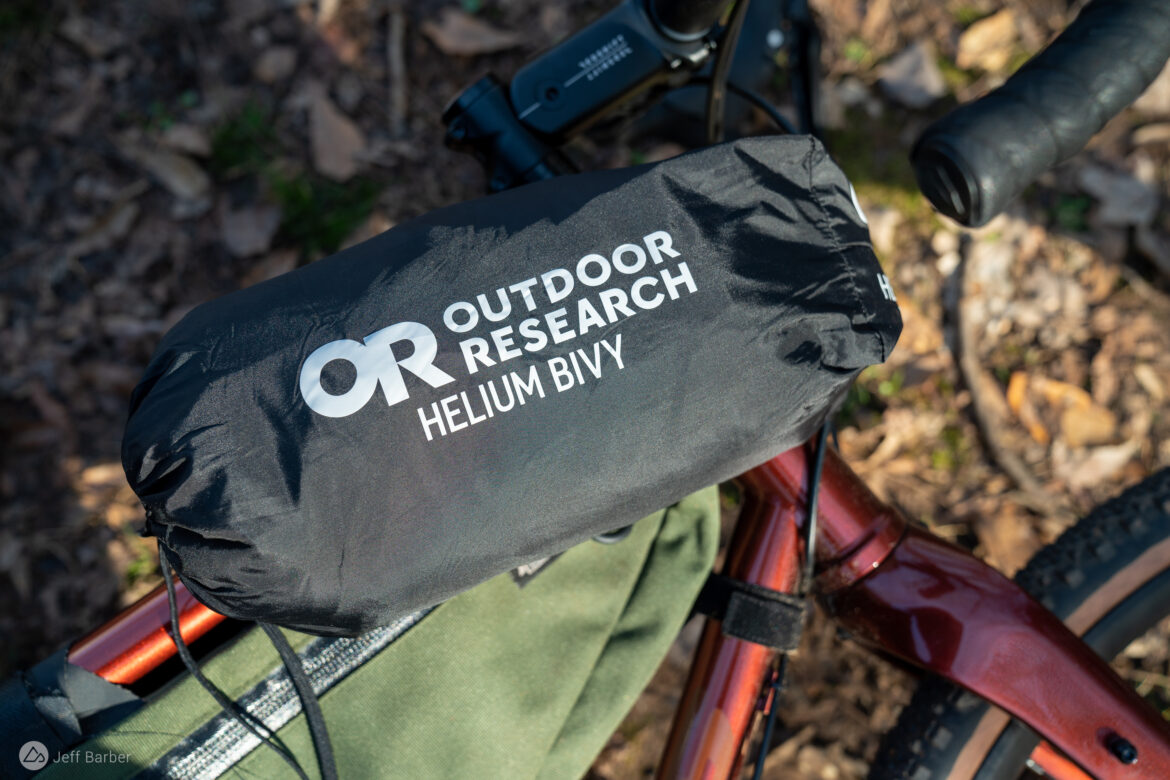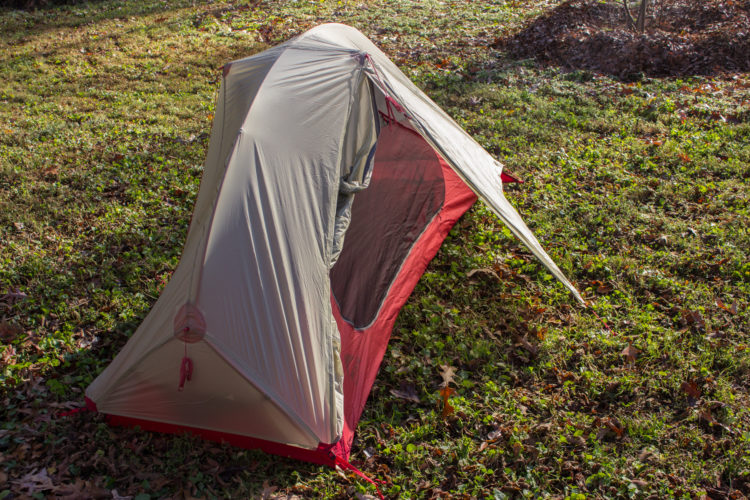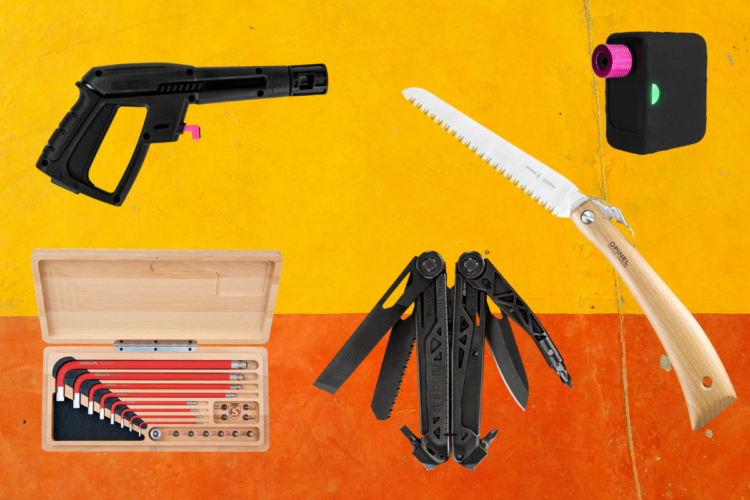
I don’t like small spaces. I’m uncomfortable on airplanes, riding in back seats, and shimmying under anything that requires me to crawl on my belly. So what made me think that I would enjoy sleeping inside the Outdoor Research Helium Bivy while bikepacking across Central Florida? I guess I hate carrying heavy gear even more than I hate small spaces. It would be an interesting experiment to say the least.
Outdoor Research Helium Bivy specs
A bivy sack is sort of like a tent, but pared way down to the size of a laid out sleeping bag. Some bivy sacks, like the Outdoor Research Helium Bivy, include a single pole at the head, though many do not. Bivy sacks are often marketed as emergency shelters, though Outdoor Research positions this one as being “ideal for light and fast missions.”
The OR Helium Bivy is indeed lightweight. Officially the whole thing weighs 15.8oz with the pole, which for those keeping track is a fifth of an ounce less than a pound. I suspect they’re not including the drawstring pack bag, and with it (and a little Florida sand hiding in the corners) mine weighs 18.6oz. That’s still about half what a good bikepacking tent weighs, though some ultralights are starting to get close to that mark.



Naturally the OR Helium Bivy is designed to keep you dry, and it’s constructed from breathable, waterproof materials with fully taped seams. There’s a bug net to provide extra ventilation on dry nights and the floor uses a slightly thicker, more durable material than the top shell to keep dew and snags at bay.
At 6’3″ tall (75″) I generally order a size long sleeping bag if one is available; regulars rarely fit me. Fortunately the Outdoor Research Helium Bivy is officially 82″ long, and I can confirm that I had room to spare at both ends even with a bag and air mattress inside. The bivy is 26″ across at the chest, tapering down to 19″ at the feet with almost 20″ of height with the pole installed.
Packed in its stuff sack, the OR Helium Bivy measures 12.25″x3.5″, about the size of a footlong sub.

Bikepacking with the OR Helium Bivy
I did a quick test with the Helium Bivy in my living room before heading down to Florida just to see how I felt inside the coffin-like enclosure. A 60-second living room test clearly wouldn’t tell me much, but it was enough to decide I would use it. Having no alternative sleeping arrangements, it would have to work.


After riding 114 miles on day one, well into the night, I was ready for sleep. Setting up the bivy involves rolling out the one-piece bag, and threading the five-segment pole into a continuous sleeve at the head of the bag. Done. The OR Helium Bivy took less time to set up than my air mattress, and just a bit longer than unrolling my sleeping bag. Less setup time equals more sleep time, at least according to my playbook.
I can confirm the bug net works as advertised. I could hear mosquitos just outside the bivy, buzzing around me and getting close to my ears, but none managed to make it inside.
According to the sleep tracker built into my watch, I slept as well as I do at home inside the OR Helium Bivy that first night. Honestly that’s pretty shocking, though not surprising given just how cozy the whole thing actually feels after a big day. The bivy literally cocoons you inside, unlike a cavernous tent with room to spare.
Of course there are downsides to the OR Helium Bivy, or any bivy for that matter. Your sleeping bag and body are constantly brushing up against the sides of the sack, and as anyone who has slept in a tent knows, touching the walls of the tent is to be avoided to keep the inside dry. Yes, the OR Helium Bivy blocks moist, outside air but it also traps in a good amount of your own respiration and perspiration. It’s clearly not as well vented as a tent with a fly, but I found it did keep me mostly dry through very damp nights and mornings, even pitched on grass.
I haven’t slept in the OR Helium Bivy in a full-on downpour, but then again I tend to avoid camping on those types of nights whenever possible. Still, I fully trust that the Helium Bivy would keep me dry(ish), at least enough to get some shut eye and survive the night. Because a bivy is basically just a wrapper for your sleeping bag, its temperature comfort range really comes down to the bag you use inside. On nights with temperatures in the upper 40s/lower 50s I was warmer than I need to be inside the Helium Bivy and a 20° sleeping bag. This setup would likely do well down into the 30s; below that I would opt for a warmer bag.


And about that pole. I love that the Outdoor Research Helium Bivy includes a pole to get the material out of my face at night, but it doesn’t always work. One night I just couldn’t get the pole to stay upright. I suspect the key is to stretch the bivy and weight it with your body such that everything it taut, but I was just too tired to figure out the problem. A tent stake could help too, and while there are a couple loops for stakes, no stakes are included. The upshot is my watch reported that I slept just fine anyway. (Take this with a grain of salt; friends joke about my ability to fall asleep just about anywhere, anytime.)

Unlike a tent, there isn’t any “extra” room inside the OR Helium Bivy. Still, I could fit small items like a flashlight and water bottle to one side, and clothes for the next day if I wanted them to be warm in the morning. I decided getting dressed inside the bivy wasn’t worth the hassle, though at one point I contemplated just standing up and hopping around in the bivy so I could take a midnight pee. I can roll over inside without getting tangled up and it doesn’t feel cramped or claustrophobic.
The OR Helium Bivy packs up quick, and you don’t have to work very hard to fit it inside the included stuff sack. Just shake it out, fold it, and roll it up with the poles just like a tent. Because it takes up so little room I was able to fit the bivy, an inflatable air mattress, a camp pillow, and 20° sleeping bag in a single handlebar roll.
Bottom line: The Outdoor Research Helium Bivy is lightweight, quick and easy to use, and surprisingly comfortable for nights out on the trail. It’s not foolproof though, and some will definitely prefer having room to stretch out in a more stable structure. Despite any negatives, it’s become my go-to for bikepacking adventures.
- Price: $199. The blue color pictured here is currently on sale for $139.30.
- Buy from Outdoor Research.
Party laps
- Lightweight and quick setup
- Enough room for tall or broad-shouldered individuals
- Less expensive than an ultralight bikepacking tent
Pros and cons of the Outdoor Research Helium Bivy.
Dirt naps
- No meaningful ventilation apart from the head
- Looks like a coffin; no room to change clothes





















4 Comments
Sep 6, 2023
Feb 18, 2023
Feb 19, 2023
Edit: I see, I did say it "might" be the best possible in the description haha. As you said, the choice definitely depends on the weather and environment.
Feb 18, 2023